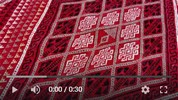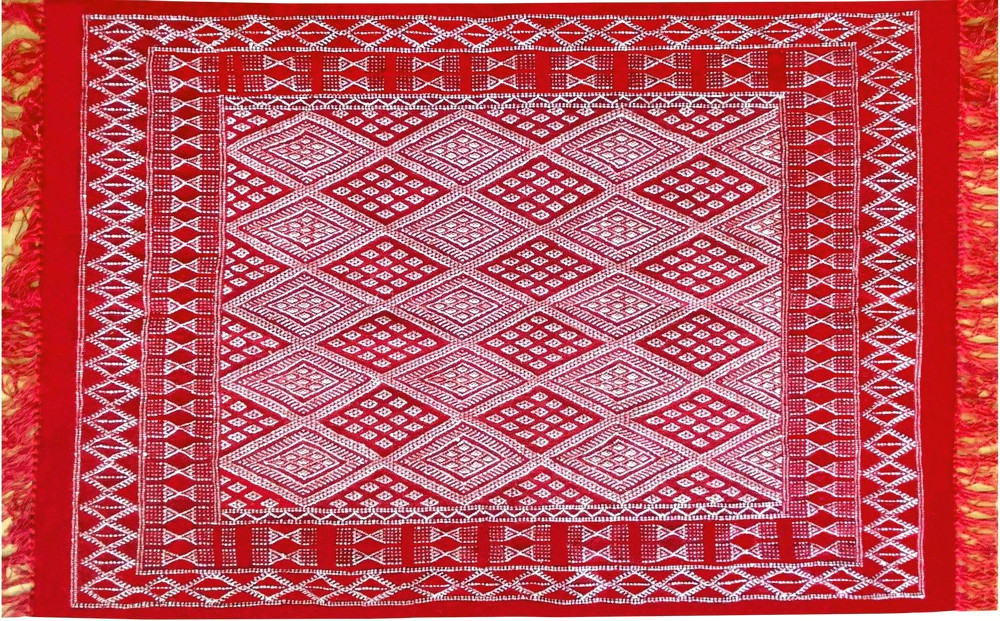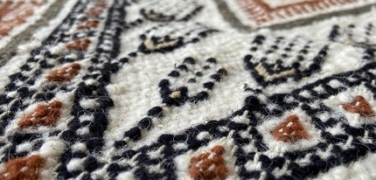Rug Margoum Eklil 171x238 cm
- Width
- 171 cm
- Length
- 238 cm
- Color
- Red White
- Compositions
- Wool
- Type
- Margoum
- Origin
- Tunisia
- Use
- Living room rug
Tunisian Margoum carpet from the city of Kairouan. Unique piece handmade by a skilled craftswoman.


Secure payment

Free shipping

15 day money back guarantee
Rug - Margoum / Mergoum - Certified "First choice" by the National Handicrafts Office of Tunisia.
This is a unique piece that will bring a tasteful decoration.
Did you know? The Margoum is a type of rug that is only made in Tunisia. It is a city rug handmade by the craftswomen from the cities of Kairouan, El Jem and Oudhref.
The margoum is a rug both woven and embroidered which gives it a smooth appearance decorated with reliefs. The mixture of its wool weft and cotton warp makes it a rigid and solid rug.
The margoums are always decorated with diamond-shaped motifs which symbolize fertility. However, there are no two identical margoums.

Here is the meaning of the main symbols of the Rug Margoum Eklil 171x238 cm :
Note: Originally, the symbolism of Berber signs refers mainly to life, the fertility of the couple and the fertility of the land. Over the centuries, the meanings have often evolved or overlapped.

Red
The colour red has a prophylactic character in ancient Berber traditions: its strength and brilliance protect against accidents and diseases; it is the universal vector of the principle of life.

The central medallion
The central medallion symbolises the gestation and the progressive enlargement of the woman's belly when the sides of the diamond or hexagon are multiplied.

The rhombus
The diamond is the Berber carpet pattern par excellence. It appears on almost all Berber carpets in the Maghreb, whether in Tunisia, Algeria or Morocco.
Meaning 1: The diamond is an ancient Berber feminine symbol that represents woman and her beauty. It represents the womb of life, the uterus or the woman's body as a whole.
Meaning 2: The eye or the mirror: what reflects or allows one to see.The representation of the eye is in the Berber culture a way of countering the evil eye. In the same way, the mirror reflects the evil eye against itself.

The 5-branch comb
Berber carpets are woven entirely by hand without shuttle or spindle. The only accessory used by the craftswomen is the weaving comb which is used to pack the wool of the carpet. It is therefore a strong symbol associated with creativity and fecundity. It is often represented on Tunisian carpets, especially on woven carpets such as kilims and margoums.
On this carpet, the combs have 5 branches. They refer to the hand of Fatma (khomsa) and its five fingers, present on many tunisian handicrafts. The khomsa is an ancestral symbol of Berber beliefs used as an amulet against the evil eye symbolizing protection, power and strength.

The waves
Male symbol referring to sensory movement and fertility. Associated with the rhombus, it signifies the coupling of man and woman.

The fibula
The fibula occupies an important place in the history of Berber culture. It is traditionally used to hang the clothes of Berber women and then derived in the form of jewellery and other accessories. Traditionally, the way it is worn indicates the social and marital status of the woman.
Symbolically, the Berber fibula represents the association of the feminine (triangle) and the masculine (needle) invoking procreation and fertility.

The spider
The spider is a great symbol of weaving, its threads being the image of the weft of the carpet. In Berber culture, it is associated with fertility and magical rites. It also represents the sun and its rays.
Data sheet
- Width
- 171 cm
- Length
- 238 cm
- Color
- Red White
- Compositions
- Wool
- Type
- Margoum
- Origin
- Tunisia
- Use
- Living room rug
Specific References








